Air vs. OpenAsset
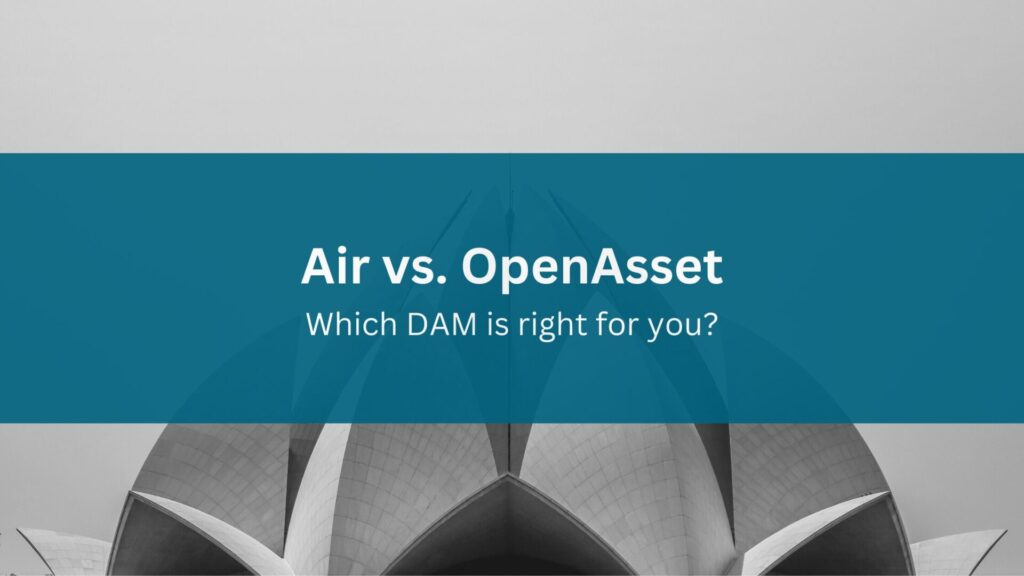
Choosing the right Digital Asset Management (DAM) system can be a game-changer for businesses aiming to streamline their digital asset organization and improve team collaboration.
However, picking the right DAM depends on many factors such as the size of your team, the industry you’re in, your budget, the specific features you need for asset management (like search capabilities, integration options, and scalability), and how you plan to use the assets (for marketing, sales, etc.).
In this blog, we’ll explore two DAM solutions: Air and OpenAsset. Air and OpenAsset both serve digital asset management needs, yet they do so uniquely, offering differing value propositions to various organizations. They distinguish themselves through their features and capabilities, catering to different preferences and requirements within the DAM space.
Air, with its user-friendly interface and lightweight DAM approach, appeals to small and medium-sized teams seeking efficiency without the extensive features of traditional systems. On the other hand, OpenAsset, designed specifically for the AEC (Architecture, Engineering, Construction) industry, offers specialized features that align with the unique demands of project-based work.
By the end of this blog, you’ll better understand which DAM solution best fits your organization’s needs.
What Is DAM?
Digital Asset Management (DAM) is like a super-organized digital library or storage system where businesses or individuals can keep, organize, manage, and share all their digital assets. It works as a central location for your growing library of digital assets. These assets can be anything digital you might use for projects or marketing while keeping them safe — photos, videos, documents, and more.
DAM helps you find the right file quickly, ensures that people use the correct version of a file, and makes it easy to share files with others who need them, significantly improving workflows and saving your team countless hours. In simple terms, it’s like having a super-efficient assistant who knows exactly where everything is stored in your digital library!
| Hand-picked related content: If you’re still unsure or simply want to know more about exactly what DAM software is, read our Ultimate Guide to Digital Asset Management now. |
What Is OpenAsset?
OpenAsset is a Digital Asset Management (DAM) platform specifically tailored for firms in the architecture, engineering, and construction (AEC) industry. It is designed with features to help these firms efficiently manage and utilize their digital assets, such as project images, documents, marketing collateral, and other media files, which we’ll go into more detail later.
OpenAsset key features include:
- A project-centric structure
- AI-powered search capabilities
- The ability to create marketing collateral
- Efficient asset categorization
- Seamless asset sharing
- Workflow management
- An Employee Module
- AI Content Assist
- AEC-specific integrations
The list goes on and on and continues to evolve as new features get added.
| Hand-picked related content: Want to learn more about how OpenAsset can transform your AEC firm? Read our blog on Top OpenAsset Features Every User Should Know. |
What Is Air?
Air offers a solution that a basic cloud storage system, like Google Drive and Dropbox, can’t provide. It presents itself as an innovative alternative to traditional DAM systems, focusing on simplifying the process of organizing, finding, and collaborating on visual content.
Air works as a lightweight DAM (a step between cloud storage and DAM software), positioning itself as a “DAM alternative for visual assets” and stating on its website that “the best DAM software isn’t even a DAM.” They opt out of the traditional digital asset management label, describing their platform as a brand workspace or “creative request software”.
Specifically, Air emphasizes a user-friendly interface that facilitates searching, giving feedback, task management, and internally sharing assets without the complexity and costs associated with conventional DAM solutions.
Air key features include:
- Smart search (search by metadata)
- A visually-oriented interface
- Commenting tools
- Asset versioning
- Public boards (boards organize content visually)
- Custom fields
- Link sharing
- Image-recognition and color-recognition smart tagging
Similar to OpenAsset, this list also continues to grow.
| Hand-picked related content: When considering different DAM solutions, check out our extensive DAM software buyer’s guide. This guide is tailored to help you make an informed decision by helping you discover the key features your organization requires in a digital asset management system. |
Air vs. OpenAsset: Top Industries
Selecting the appropriate DAM system is largely influenced by your industry’s unique requirements, workflows, and compliance standards. Each industry has unique demands that determine the features and functionality needed in an ideal DAM solution.
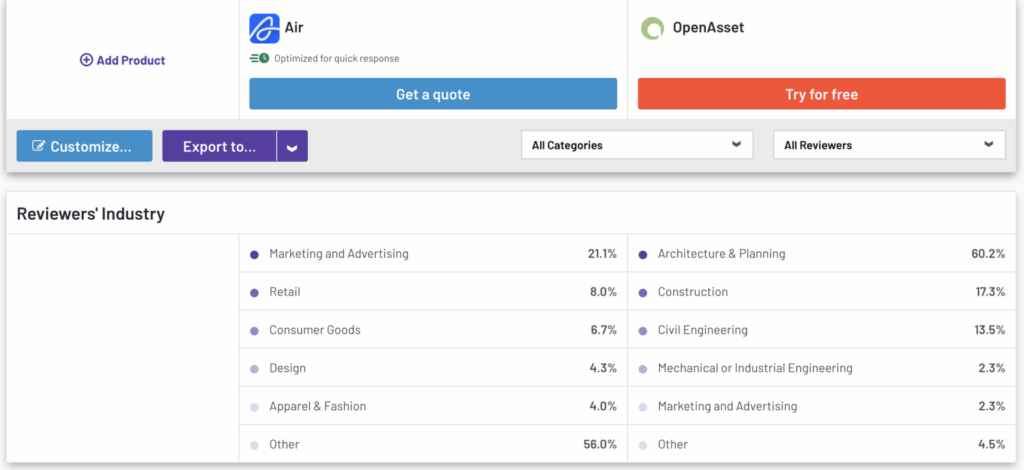
Here’s how Air and OpenAsset compare when it comes to the top industries they serve:
Air
Air is the Creative Operations System designed for marketing and creative teams, which means it has features specifically tailored for managing creative assets. This DAM tool is primarily designed to support team collaboration and task management, making it especially appealing to smaller organizations looking for cost-effective solutions without the complexity of advanced DAM software features.
However, larger enterprise teams may also find Air beneficial for its specific features, catering to their selective needs without overwhelming them with unnecessary functionalities.
As advertised on their site, Air caters to various industries, including e-commerce and retail companies, agencies, nonprofits, and academic institutions. Here’s a complete list of the industries they serve:
- E-commerce & DTC
- Agencies
- Media & Entertainment
- Non-profits
- Athletics & Sports
- Education
- Marketing
- Creative
Air is designed to streamline the management of digital assets for teams and organizations across these sectors, enhancing their efficiency in handling visual content.
However, because of the wide range of industries to cover, Air does not have specific features tailored to each industry, making it less suitable for industries and firms that require specialized functionalities for project management, asset tracking, and compliance documentation.
OpenAsset
On the other hand, firms of all sizes choose OpenAsset (with most firms falling in the mid-market segment) for its ability to streamline project-based asset management and enhance workflow efficiency in the AEC industry.
Additionally, OpenAsset is highly specialized in the following industries:
Its features are tailored to meet the specific needs of AEC firms, such as project-based asset organization, integration with AEC-specific software, and tools to manage and showcase project portfolios and resumes.
However, besides AEC, OpenAsset is also suitable for other professional services firms that manage numerous project-based assets, such as real estate and design firms.
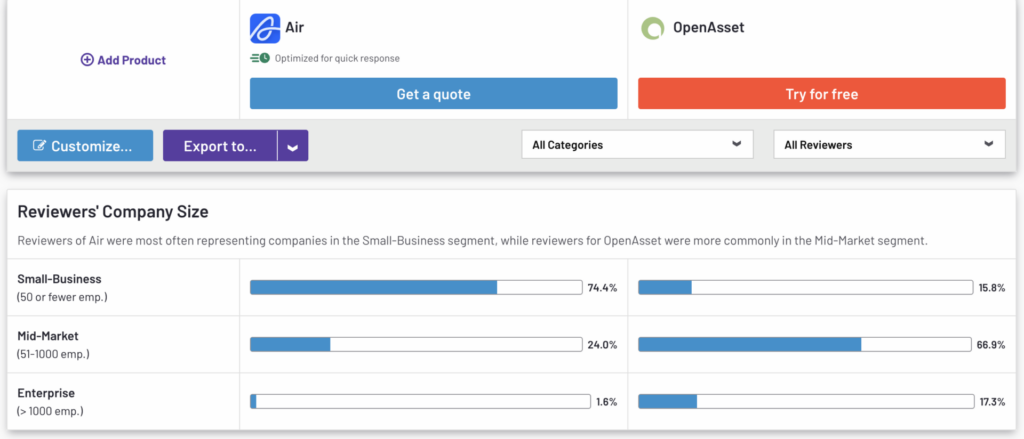
| Hand-picked related content: Learn about the top DAM features you should look for when shopping for the perfect DAM solution by reading our blog on the Most Important DAM Features now. |
Air vs. OpenAsset: Capabilities
Your organization’s creative workflow relies on your Digital Asset Management (DAM) system. An effective DAM should organize your assets, enhance productivity, foster collaboration, and allow your team to focus on tasks that increase revenue.
Let’s compare OpenAsset and Air to evaluate how they stand against each other in terms of essential DAM capabilities.
Integrations
Integrations ensure that assets can flow effortlessly between different stages of a workflow, from creation to publication, without the need for manual transfers or conversions. They improve efficiency, reduce errors, and allow for a more streamlined and automated workflow, making the management of digital assets more effective and less time-consuming.
Additionally, the integrations your company requires for its workflow will be closely related to the industry in which you operate. Here’s how Air’s and OpenAsset’s integrations compare:
Air
Air offers a limited selection of integrations. However, they claim to have many more integrations planned, and their website displays a “Request an integration” button for future requests.
Current Air integrations include:
- Zapier
- Canva
- Adobe Premiere Pro
- Slack
While this is a limited selection of integrations (as mentioned before), with their Zapier integration, you can connect Air with thousands of tools (Asana, Airtable, MailChimp, etc.) to better automate your workflows — with zero coding required. However, keep in mind that Zapier is only available on the Enterprise plan — limiting what you can do on the Air’s free plan.
Moreover, given Air’s focus on creative teams, its integrations mainly focus on asset creation, which requires a manual process for downloading and uploading content to external platforms. Depending on your needs, this setup can be less than ideal for marketing teams, as it may add extra steps to their workflow.
OpenAsset
OpenAsset is designed with the AEC industry in mind, offering specialized integrations with the tools and software AEC firms often use, including popular CRM and ERP systems and Adobe products. These integrations foster a more efficient workflow for managing digital assets and project management tasks, catering specifically to the unique needs of AEC sectors.
OpenAsset integrations include:
- Procore
- AEC 360
- Deltek Vision
- Deltek Vantagepoint
- Affinity
- Microsoft Word, PowerPoint, and Excel
- Okta
- Salesforce
- Unanet/ Cosential CRM
- Templafy
- InDesign
OpenAsset’s integration with document creation tools, like InDesign, allows users to effortlessly access images from their asset library and use the drag and drop function, which makes it significantly quick to upload into your InDesign and PowerPoint files.
This streamlined approach removes the need to search separately for and download assets, saving time and promoting consistency.
Moreover, similarly to Air, OpenAsset also provides REST API access, enabling organizations to develop custom integrations with other tools essential to their operations.
Search
Regardless of the amount of storage space utilized, the ability to quickly find your digital brand assets is critical. This capability is a fundamental feature of any efficient DAM system.
Effective search capabilities are crucial in digital asset management because they allow users to quickly find the exact files they need among potentially thousands of assets. This efficiency saves time and reduces frustration, enabling teams to focus on their creative and productive tasks rather than getting stuck searching for assets.
Here’s how Air and OpenAsset tackle searching in their software:
Air
Air was designed with searchability in mind. Their smart search feature automatically applies AI-generated keywords as users search. It enables users to find assets through metadata like creation date, location, and creator. You can also add custom tags to your assets as needed.
Further, the platform offers automated tagging capabilities, including color and image recognition— facilitated by Paige, an AI-powered search assistant.
This approach allows users to ask Paige for help in finding assets, similar to asking a colleague, streamlining the search process significantly. However, note that this AI enhancement is only available for Air’s Enterprise plan.
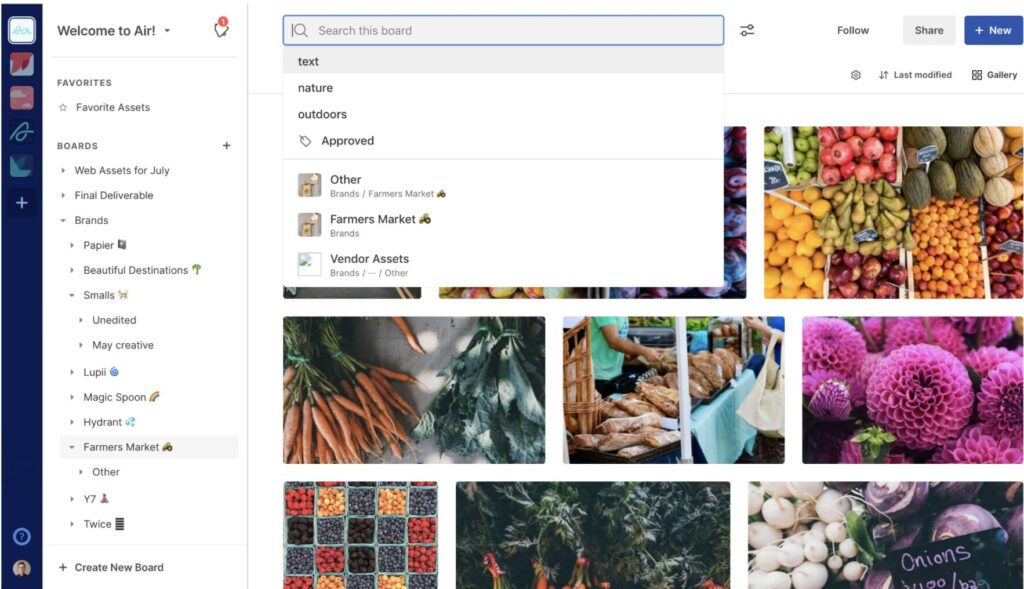
It’s also worth mentioning that although Air uses auto-tagging, it often generates numerous irrelevant tags that don’t align with an organization’s specific taxonomy. This means that when uploading, assets may need to be tagged manually.
This discrepancy can lead to inconsistent tagging practices within teams, where the same item might be labeled as “car”, “cars”, “vehicles”, or “Automobile” by different members, highlighting a need for a more unified tagging strategy.
Moreover, Air doesn’t offer a public, searchable asset library. This means Air requires either invitations to your account or an enterprise plan upgrade for ‘view-only’ access, accumulating costs per invitation.
Alternatively, using shareable links leads to a more inconvenient file-sharing method (similar to Dropbox or Google Drive), complicating the process of sharing creative materials with external partners.
OpenAsset
OpenAsset makes it easy to find what you need, allowing AEC firms to effortlessly search for your best digital assets to create winning proposals.
OpenAsset implements a standardized keyword taxonomy and adopts a project-based structure. The DAM software ensures that your assets remain easily searchable and accessible throughout their lifecycle. This approach promotes long-term organization and facilitates seamless retrieval of your valuable assets.
Within your OpenAsset system, you can search by:
- Project keywords
- Project Metadata
- File keywords
- File metadata
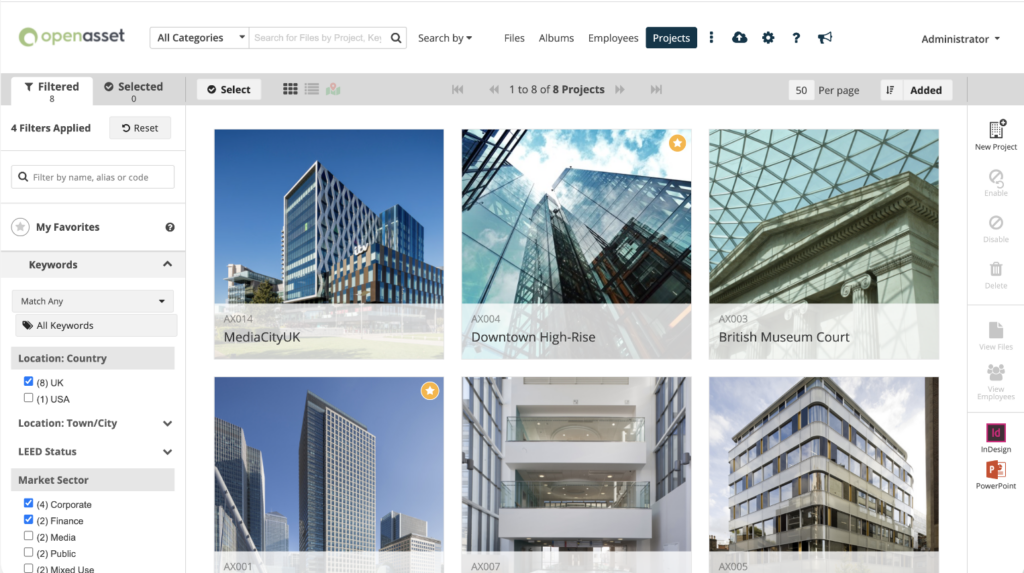
Moreover, OpenAsset’s distinctive search feature uses artificial intelligence (AI) to do more than just find the correct files; it also helps users in finding additional relevant assets that might have been missed.
The advanced integration of AI improves the search process, leading to a more effective discovery of assets. The platform’s sophisticated search tools and extensive tagging system enable users to quickly find specific images or delve into discovering new ones in the system.
Additionally, OpenAsset allows users to effortlessly create selections and albums of images based on specific search criteria. A major advantage is that these images can be directly utilized in applications such as InDesign and PowerPoint, eliminating the need to download the files beforehand.
The robust tagging system makes it easy to find the appropriate asset every time, making the search process efficient and user-friendly, particularly when managing large quantities of assets.
| Hand-picked related content: Learn how OpenAsset leverages AI to Create Fast and Flawless Employee Bios for RFP Resumes. |
Organization
Organization within a DAM system ensures that assets are easily and quickly accessible. Solid organization helps avoid asset duplication, makes it easier to manage permissions and copyrights, and supports efficient collaboration by helping each team member find the right assets for their needs.
This structured approach enables teams to focus on creative and strategic tasks rather than spending unnecessary time searching for files.
Regardless, for long-term organization and easy retrieval of assets, you need a robust DAM tailored to your industry. Let’s take a look at what organization looks like in Air and OpenAsset:
Air
Air offers a user interface that prioritizes visual assets, featuring clear image previews within a layout reminiscent of a mood board. This design enhances the visual appeal and organization of digital assets.
Additionally, Air enables visual organization of content through boards and sub-boards, where an image exists on multiple boards without creating duplicates.
Boards can be viewed in Gallery, Table, or Kanban formats to suit different needs. The Kanban view, in particular, facilitates easy drag-and-drop of content between boards, simplifying the process for rapid project approvals.
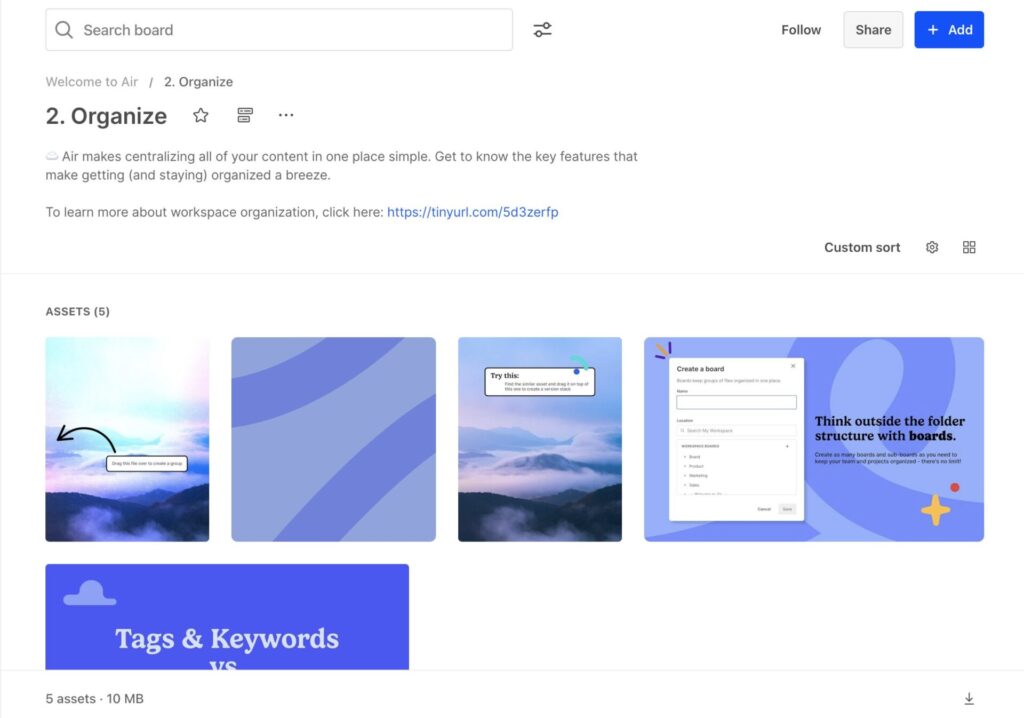
OpenAsset
OpenAsset enables the organization of digital assets in a project-centric manner. This feature is especially beneficial for AEC firms, where an abundance of visual content and documents are produced for each project. By assigning assets to designated projects, users can efficiently find the materials they need.
For sustained organization and straightforward retrieval, OpenAsset uses a consistent keyword taxonomy coupled with a project-focused structure. This approach guarantees that assets remain easily searchable throughout their entire lifecycle.
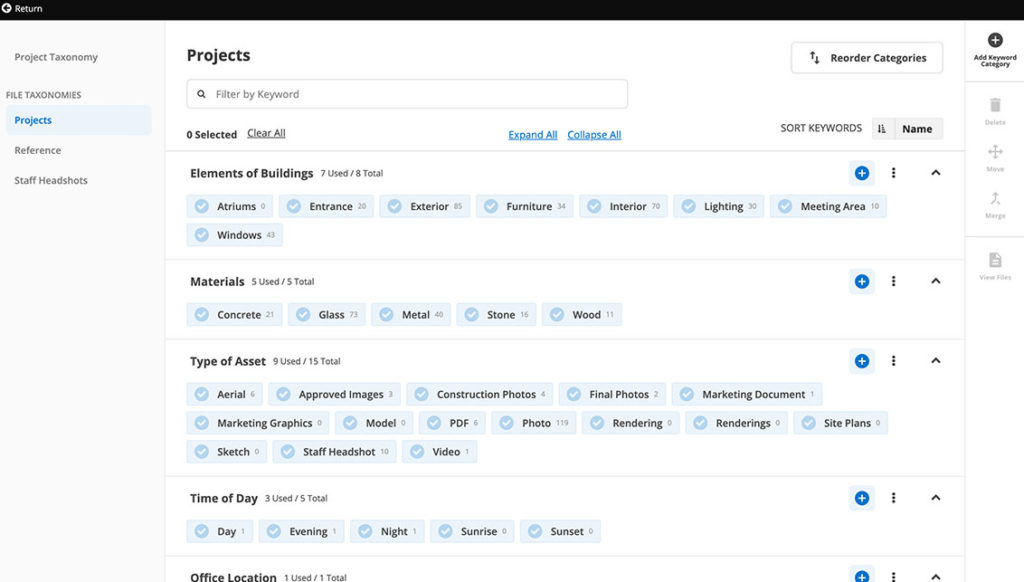
Sharing and Collaboration
Sharing and collaboration in a DAM system facilitate efficient teamwork by allowing members to easily access, review, and work on digital assets together. This capability ensures that everyone is on the same page, reduces the risk of using outdated or incorrect files, and speeds up the approval process.
Effective sharing and collaboration features in a DAM can significantly improve project workflows, enhance communication among team members, and streamline the overall creative process. Here’s how Air and OpenAsset compare:
Air
Air offers several features to support sharing and collaboration. The platform supports real-time collaboration by enabling several users to simultaneously work on the same project without worrying about version control or the time-consuming process of emailing files.
You can share individual assets or entire boards (Air’s version of folders). To start, you can effortlessly upload and download files of any size in Air. To share an asset, simply generate a share link, which remains active indefinitely, and distribute it via email, Slack, or text message.
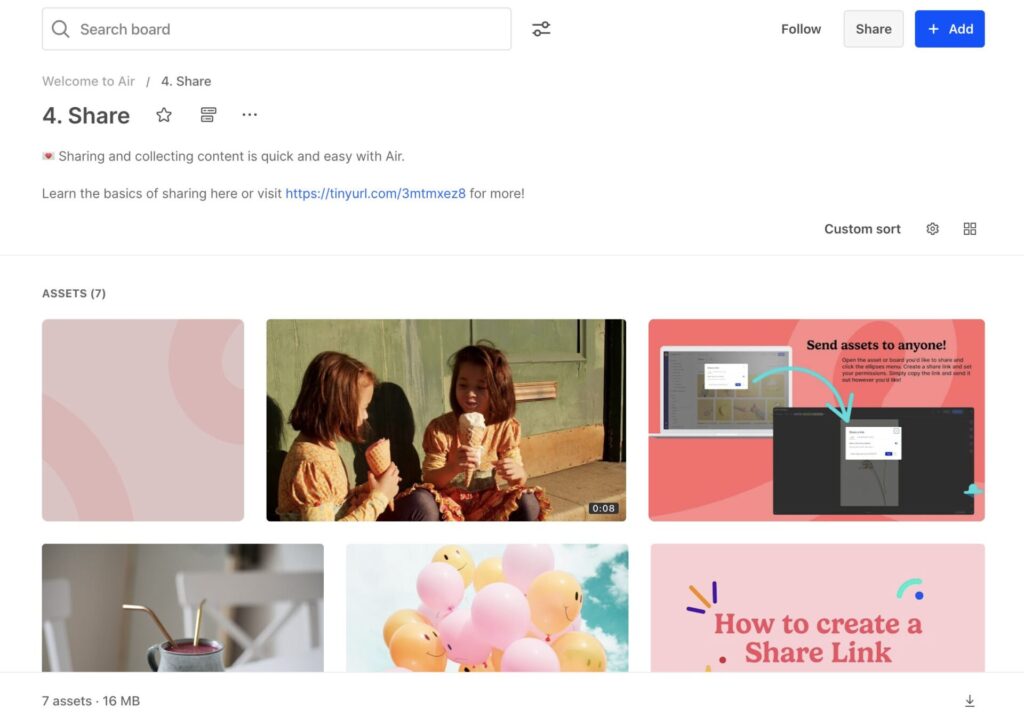
Moreover, ‘Permissions’ vary slightly between sharing an asset or a board, but it allows for customized settings for viewing, downloading, uploading, and commenting, ensuring tailored access and interaction levels. Air allows you to attach feedback to your assets right in Air, with precise annotation and timestamp capabilities for faster clarity and alignment.
When you share an asset using Air, the recipients can access it directly through the provided link, without the need for an account creation. They can simply click the link, upload or download the necessary files, and proceed with their tasks, all via their web browser. This can streamline the sharing process, making it straightforward and hassle-free for everyone involved.
However, as mentioned earlier, using shareable links can lead to a more inconvenient file-sharing method (similar to Dropbox or Google Drive). If you consistently work with retailers, wholesalers, and PR teams, this process might not be ideal for you and your partners.
Air also offers the option to passcode-protect any board or asset. Just keep in mind, that this is only available to those with a Pro plan or higher.
OpenAsset
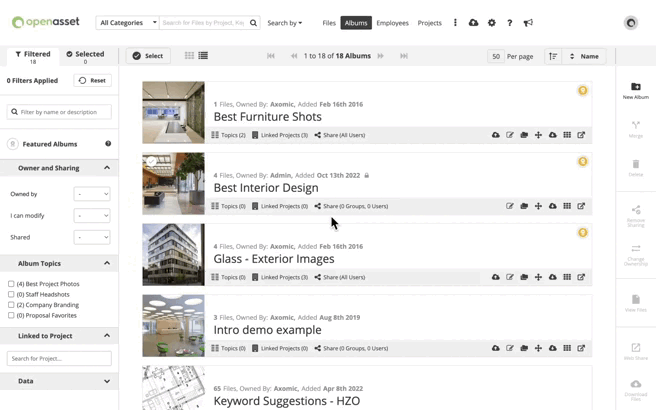
OpenAsset simplifies the secure sharing of your images and digital assets exclusively with the intended recipients, precisely when they require access. Users benefit from comprehensive control over distributed assets through features such as download monitoring and external access control.
These functionalities offer peace of mind to organizations of any scale, ensuring that their valuable assets are protected and accessed only by authorized individuals.
Moreover, OpenAsset provides the capability for users to distribute collections of assets to both internal and external partners. These collections can be shared via links, with the option to secure them with a password or set an expiration date for enhanced security.
Additionally, with OpenAsset’s Portal feature, users can effortlessly create a Portal and provide access to colleagues, partners, and clients through a unique link. This link showcases a preview of images, accompanying contextual information, and, if desired, download links—eliminating the need for third-party file-sharing services like WeTransfer or Dropbox.
Lastly, OpenAsset’s version control feature is crucial for collaborative projects that often go through several document changes. It guarantees that team members are using the most recent versions of documents and visual assets, which is vital in fields where precision and accuracy are key.
Cost and Value
Cost and value directly impact the return on investment (ROI) for an organization. A DAM should offer a balance between its price and the efficiency, productivity, and organizational benefits it provides.
Investing in a DAM that aligns with an organization’s size, needs, and workflow can lead to significant savings in time and resources, making the initial cost a worthwhile investment. On the other hand, a system that’s too expensive or doesn’t meet the specific needs can result in wasted resources and a low ROI.
Let’s take a look at how Air and OpenAsset measure up to cost and value:
Air
Air claims that the primary difference between a free account and a paid account is that free accounts only have access to 5 GB of storage and two workspace seats. While this is true, along with the number of boards you can create (you can have up to 50 boards for the free version), the features available dramatically decrease for the Free version.
Different pricing tiers offer different storage, boards, and workspace seat numbers, as seen below:

If you start using Air for free, you will have nearly full functionality of all the essentials, such as:
- AI-powered keyword search
- Visual support for images, videos, PDFs, PPTs and more
- Secure storage for all file types
- Advanced sorting and filtering
- Air Flow desktop app with 2-way sync
- Activity notifications via Slack, email, and Air
- Import from Dropbox, Google Drive, and Box
However, beyond that, when it comes to organization, collaboration, integrations, support, and more, features are very limited for the free version. This is also true for the Plus version.
Some of Air’s best features are unavailable on the Free and Plus plans. You’ll have to upgrade to the $300 per month Pro plan to access them, and even then you won’t have access to all the features. This can prove expensive for smaller businesses (based on the volume of files you need to store and organize).
Additionally, you might find yourself paying for features that are unnecessary for your needs, leading to the inefficient use of resources.
Enterprise Cost
Air boasts its pricing transparency when compared to other DAM systems. However, while Air prices are displayed on their website for most plans, pricing for Air’s Enterprise plans is not disclosed on their website. This is specifically important for teams that require more than the 3 TB of storage offered by the Pro version. You’ll need to get in touch with an Air representative to find out how much this will cost you.
For enterprise clients, storage and pricing are customized to meet their unique requirements, offering a range of tailor-made features. These include personalized data migration services, customizable member roles, bespoke usage reporting, and a dedicated account manager to handle all support questions.

Ultimately, Air’s scalable pricing model is particularly beneficial for startups or marketing teams with limited budgets and digital asset libraries requiring less than 3TB of storage. This helps avoid the need for a heavy initial investment in software.
OpenAsset
While OpenAsset’s pricing is not as transparent as Air’s, if you require more than 3TB of storage or additional industry-specific features, OpenAsset’s pricing might be more affordable, considering the value you would get out of the DAM tool.
OpenAsset provides two onboarding options:
- Premier: Designed for larger firms or those with extensive migration needs, includes up to 10 custom templates in the first year.
- Plus: Suitable for simpler setups, it offers one data migration and up to 5 custom templates.
Plus, users benefit from dedicated implementation managers, enhancing the setup experience.
Additionally, data storage costs reflect the secure and highly available nature of the service, with the first 100GB priced at $1.40 per GB per month.
Basic user licenses are reasonably priced, and OpenAsset provides detailed comparisons to help you choose between basic and full user subscriptions. Basic user licenses cost approximately $200 per year, offering significant savings over full-user subscriptions.
It’s important to note that OpenAsset’s efficiency in streamlining processes can lead to considerable labor cost reductions, with an example pricing range for a 100-person company using ten licenses and some integrations estimated between $12,000 to $18,000 annually, plus data usage costs.
| Hand-picked related content: Learn more about the cost of OpenAsset by reading about the Most Common Questions about OpenAsset. |
Air: Best DAM for Small-Business Creative Teams
Air stands out as the ideal digital asset management solution for creative teams. This lightweight DAM tool is engineered with creative workflows in mind, incorporating features for the efficient management of creative assets.
Specifically, small and growing brands favor Air for streamlining content workflows, featuring project management tools and a user-friendly interface to enhance creative processes.
Air’s aim to simplify asset management intends to remove the common challenges of adopting DAM software, such as lengthy migration processes and costly contracts, thus making their solution more accessible and affordable for smaller businesses with limited resources.
However, while Air excels in managing content operations and avoiding costly contracts, it still lacks some critical DAM features and has limited capabilities needed by creative teams for the widespread distribution of visual content. For example, sharing product visuals with retailers or wholesalers requires inviting (and paying for) each user for access, unless you upgrade to an enterprise plan.
This makes Air’s solution ideal for creative or marketing teams handling one or two projects at a time, or teams that mainly share files with and collaborate within their organization.
Moreover, teams focused on optimizing online publishing and brand management, or those seeking specific tools like templates for repurposing creative materials, often don’t opt for Air’s solution due to its lack of comprehensive tools that meet their needs.
Ultimately, if your small team is looking to transition from basic tools like Google Drive and Dropbox to a more structured system without requiring a full-fledged digital asset management system, Air’s lightweight DAM solution might be right for you.
OpenAsset: Best DAM for AEC Firms
OpenAsset distinguishes itself for AEC firms by offering features specifically tailored to their unique needs, unlike platforms like Air, which provide a wider but less specialized feature set. This dedication to meeting the specific demands of the AEC industry makes OpenAsset particularly appealing to firms within this space.
OpenAsset emphasizes ease of use, project-based organization, and integration with leading AEC document creation tools and partners to streamline workflows in AEC firms. Its AEC-specific functionality makes it a preferred choice for firms in this sector, distinguishing it from more generalist DAM solutions like Air.
Moreover, OpenAsset significantly simplifies the task of creating customized resumes for bid proposals, a crucial advantage for AEC professionals. Its Employee Module enhances organizational efficiency by automating resume document creation and enabling seamless synchronization of employee data with your CRM or ERP system, streamlining internal processes and saving valuable time.
Lastly, OpenAsset constantly enhances its services to better support AEC marketing professionals. Their commitment to this specialized field makes OpenAsset an unparalleled DAM solution for the AEC industry, with many more features tailored to meet your needs.
Choosing the Right DAM: Air vs. OpenAsset
Originally developed as a tool for creative workflows, Air offers features like timestamps, versioning, and extensive storage, facilitating efficient management of creative collaboration. However, it falls short in providing key asset utilization features essential for AEC marketing teams, highlighting a gap in its utility for specialized industry needs.
For example, OpenAsset is more specialized, targeting the AEC industry with its project-based approach, while Air is a versatile tool, better suited for a variety of creative professionals who work across different types of media.
The choice between them largely depends on the specific needs of your industry and workflow.
For a more comprehensive understanding, we provide in-depth comparisons of other platforms like Bynder, Brandfolder, Canto, Adobe Bridge, and more, to help you evaluate all your options.
Ready to see OpenAsset in action?
The post Air vs. OpenAsset appeared first on OpenAsset.